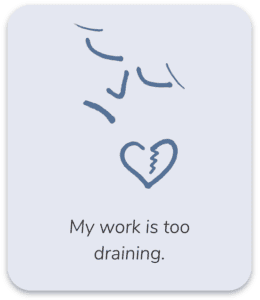Many people dread group meetings, especially introverts. Avoiding gatherings means missing out, so then what? With a few tweaks, group gatherings can be enjoyable and productive, even for introverts.
It’s not that we need to “get the quiet folks in the room to speak up.”
The problem is a lack of good meeting structure. Good structure can make it easier for everyone to contribute meaningfully. It means all voices have an opportunity to be heard in a way that feels helpful to the individual and the mission.
I have discovered that making meetings work better for introverts leads to making meetings feel better for everyone! That’s including anyone who feels nervous to share in a meeting AND it helps those who boldly speak out too.
In this post:
– Why Introvert-friendly Meetings Help Everyone.
– Simple Meeting Structures That Help.
– How I Create Introvert-friendly Meeting Structures

Why Introvert-friendly Meetings Help Everyone
Introverts do better when they have room to think before speaking. Actually, most people think better and are more likely to contribute meaningfully in a meeting when there is breathing room built into the structure. Even extroverts benefit because sometimes they don’t realize they benefit from a pause.
In my experience, adding in breathing room doesn’t need to make the meeting longer.
In fact, it makes it more efficient and more effective. Less detours and nonsense.
The typical meeting rushes past breathing room. It’s typically a free-for-all, with the loudest and fastest contributors ending up with more air time. It doesn’t mean their voices have the wisest contributions. It’s just what happens when there isn’t a clear structure.
Unstructured meetings are inefficient, ineffective, and draining of good energy. No wonder most people dread it, except maybe the one who spouted off and assumed everyone agreed with them.
Simple Meeting Structures That Help
Creating an effective meeting structure for introverts, and everyone, is so much about adding in breathing room, which should be simple enough since we all know how to breathe.

Adding in breathing room can look like these examples:
- Send out the agenda in advance so people can form thoughts before landing in the buzz of the meeting. (We’ve heard this advice but it’s often neglected.)
- In the meeting, introduce a discussion topic or question, and then give a quiet moment for people to think before there’s a round to share thoughts. Silence is golden.
- Have people complete a poll so that everyone can contribute even if they don’t share vocally.
- Use rounds, with a clear order, so it’s clear when someone’s turn is coming up. This relieves the stress of wondering if someone will jump in over them, and the person is not caught off guard for their turn.
- Allow people to pass and come back to them during a round.
These are simple things to do, and they add up to more happiness, more effectiveness, less conflict, and less loneliness in the world. In other words, it’s so worth taking a moment to rethink how you facilitate meetings.
Bonus: You’ll end up with more loyal group members which creates an ongoing waterfall of positive impact.
I find that these simple methods work for all kinds of meetings: team meetings at work, support groups, mastermind groups for solopreneurs, community volunteer group, church committee, etc.
How I Create Introvert-friendly Group Meetings
As a specialist in supporting introverts and highly sensitive people (HSP), I have thought a lot about what will create the kind of group meeting structure that works best for everyone there. I have a vested interest in keeping my people happy. 🥰
In my work as a coach, I facilitate various group gatherings, whether as part of my courses or my business support groups. I also facilitate meetings in community groups I’m part of.
In all these cases, I have heard positive feedback from introverts, extroverts, HSPs, people of color, and people who typically dislike meetings. They say my gatherings are refreshingly meaningful, beneficial, and welcoming. This makes me so happy.
I’ve rarely felt a sense of community. I joined the group and it became an incredibly nourishing part of my life. Val folds you into a group that creates an easy structure for sharing, learning, and support. It feels magical.”
~Jessye, introvert and HSP
Here are things I do to make the coaching groups I lead go well for everyone:
- I let people know the topic and structure in advance.
- I have simple group guidelines that we go over together. (Examples: confidentiality, no judgment)
- I start each meeting with a simple guided grounding, or “mindful moment,” with at least a few slow breaths. This is to give room for the mind to settle into a new space.
- Sharing is done in rounds so that everyone has an opportunity to contribute.
- Before each round, I provide a topic or prompt, summarized into the chat for easy reference.
- Before the round begins, there’s a quiet moment for everyone to gather their thoughts.
- People know when their turn is coming. I put the order of the sharing “circle” in the Zoom chat.
- People can always pass and come back. Or there’s always the option not to share, but in reality even people who don’t normally share in other meetings tend to share because of the welcoming container.
- I leave time after each person so that one or two peers could offer reflections or validation. I provide guidance on how to respond.
- I allow silence instead of rushing to the next thing. Sometimes people don’t know they have a question until they have a moment.
- Sometimes I include time for journaling, or lead a short guided inner journey, or time to tune in inside. That way, members can hear their own inner wisdom, not just the feedback of others.
- At the end, there’s another moment to breathe, to notice what’s staying with you, write it down, and to share a sentence or two about that in a final round.
These small things give room to go deeper, to what matters. It adds up to members coming away with something meaningful, memorable, and inspired into action. Not to mention feeling connected in a way that is so needed. When you feel like people have your back, so much is possible.
Bottom Line
- Introverts don’t need to get better at meetings. Meetings need to get a little structure.
- Making meetings introvert-friendly is good for everyone, including the organization.
- Small shifts in structure are easy to do.
- Making it better is mostly about creating more breathing room to think before sharing.






